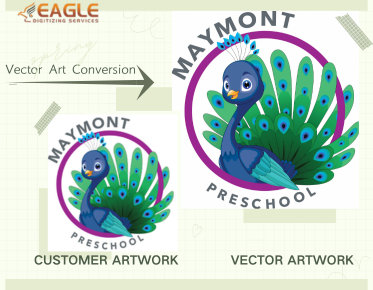Design Hacks for an Amazing Embroidery Store/ Eagle Digitizing
Starting an embroidery store is an exciting venture that combines creativity, craftsmanship, and business acumen. Whether you're an experienced embroiderer or new to the craft, designing a store that stands out and attracts customers requires careful planning and attention to detail. From identifying your niche to crafting a memorable storefront, every aspect plays a crucial role in your store's success. If this post spurred your interest and you want to find out more about Embroidery Digitizing, please feel free to contact us.
Finding Your Niche
Identifying Your Target Audience
The first step in designing your embroidery store is to identify your target audience. Who are you trying to reach? Are they hobbyists, professional designers, or DIY enthusiasts? Understanding your audience helps tailor your products and services to meet their specific needs. Conduct surveys, engage with potential customers on social media, and analyze market data to get a clear picture of your ideal clientele.
Researching Market Trends
Stay ahead of the competition by researching current market trends. What’s popular in the embroidery world right now? Are there specific patterns, materials, or techniques that are in demand? Attend trade shows, read industry publications, and follow influential embroidery artists to keep your finger on the pulse of the market. This knowledge will help you stock trendy items and offer services that attract customers.
Choosing the Right Location
High Foot Traffic Areas
Selecting the right location is pivotal for your embroidery store's visibility and accessibility. Look for areas with high foot traffic, such as shopping centers, busy streets, or near popular landmarks. A location with ample pedestrian movement increases the chances of walk-in customers and impulse buyers discovering your store.
Accessibility and Parking Considerations
Ensure your store is easily accessible to all customers, including those with disabilities. Adequate parking is also essential, as it provides convenience for customers who drive. Evaluate the parking situation and consider options like nearby parking lots or valet services if on-site parking is limited.
Setting Up Your Store Layout
Designing an Inviting Entrance
Your store's entrance is the first impression customers have, so make it inviting. Use bright, welcoming colors, and clear signage to draw people in. Consider adding planters or decorative elements that reflect your store’s personality and style.
Creating a Comfortable Shopping Flow
Inside the store, design a layout that encourages easy navigation and a pleasant shopping experience. Use wide aisles, clear signage, and intuitive product placement to guide customers through your store. Arrange your products in a logical order, with popular items easily accessible and complementary products nearby.
Essential Equipment and Supplies
Must-Have Embroidery Machines
Invest in high-quality embroidery machines that meet the demands of your target audience. Whether it's commercial-grade machines for large orders or versatile models for intricate designs, having the right equipment is crucial. Offer demonstrations and hands-on experiences to showcase their capabilities.
Stocking Quality Threads and Fabrics
Stock a wide variety of threads and fabrics to cater to different tastes and projects. Quality materials not only ensure better results but also position your store as a reliable source for serious embroiderers. Consider offering eco-friendly and specialty options to attract a broader customer base.
Crafting a Memorable Storefront
Eye-Catching Signage
Your storefront signage should be bold, readable, and reflective of your brand. Use unique fonts and colors that stand out and make a statement. Remember, your sign is your silent salesperson working 24/7 to attract customers.
Attractive Window Displays
Create window displays that captivate and intrigue passersby. Use your best products and arrange them in themes or color schemes that change regularly. An engaging window display can entice people to step inside and explore more.
Interior Design Tips
Choosing the Right Color Palette
The colors you choose for your store's interior can influence customer behavior. Soft, warm colors create a welcoming atmosphere, while bright, vibrant hues can energize and inspire. Choose a palette that aligns with your brand and creates the desired mood.
Incorporating Comfortable Lighting
Good lighting is essential for both ambiance and functionality. Use a mix of natural and artificial lighting to create a well-lit, inviting space. Highlight key areas like displays and workstations to draw attention and facilitate a pleasant shopping experience.
Display Techniques for Your Products
Using Mannequins and Models
Showcase your embroidered items on mannequins and models to give customers a clear idea of how they look in real life. This technique is particularly effective for wearable items like clothing and accessories, making it easier for customers to envision themselves using your products.
Arranging by Themes and Seasons
Organize your products into themes or seasonal displays to create a cohesive shopping experience. Whether it’s a holiday collection or a themed event, curated displays can inspire customers and boost sales.
Creating a Cozy and Welcoming Atmosphere
Adding Comfortable Seating Areas
Provide comfortable seating areas where customers can relax and contemplate their purchases. This is especially important for those who might bring friends or family along. Cozy seating makes your store feel more inviting and customer-friendly.
Offering Refreshments and Snacks
A small refreshment station with complimentary drinks and snacks can enhance the shopping experience. It’s a simple gesture that shows you care about your customers’ comfort, encouraging them to stay longer and explore more.
Organizing Your Inventory
Efficient Storage Solutions
Implement efficient storage solutions to keep your inventory organized and accessible. Use shelving units, bins, and labeling systems to make finding and restocking items quick and easy. This not only improves workflow but also ensures customers can always find what they need.
Easy-to-Find Product Labels
Clear, concise product labels help customers quickly locate and identify items. Use large, readable fonts and include essential information like price, material, and size. Consider color-coding or using icons for different categories to streamline the shopping process.
Setting Up a Creative Workspace
Dedicated Areas for Design and Production
Create designated areas for design and production to keep your store organized and efficient. These spaces should be well-equipped with all necessary tools and materials, providing a functional environment for creating and fulfilling orders.
Inspirational Decor for Motivation
Decorate your workspace with inspirational elements that fuel creativity and motivation. Use artwork, motivational quotes, and samples of your best work to create a stimulating environment that encourages productivity and innovation.
Incorporating Technology
Point of Sale Systems
Invest in a modern point of sale (POS) system that streamlines transactions and provides valuable sales data. A good POS system can manage inventory, track sales trends, and offer loyalty programs, enhancing both customer experience and operational efficiency.
Online Inventory Management
Use online inventory management tools to keep track of your stock in real time. This technology helps prevent overstocking or running out of popular items, ensuring you always meet customer demand. It also simplifies reordering and reduces manual errors.
Marketing Your Embroidery Store
Building a Strong Online Presence
In today's digital age, establishing a strong online presence is essential. Create a user-friendly website showcasing your products and services. Utilize search engine optimization (SEO) techniques to attract organic traffic and engage with customers through informative blog posts and newsletters.
Utilizing Social Media Effectively
Leverage social media platforms to promote your store and connect with your audience. Share high-quality images of your products, behind-the-scenes looks at your creative process, and customer testimonials. Engage with followers through interactive posts, contests, and live sessions to build a loyal community.
Hosting Workshops and Events
Organizing Embroidery Classes
Offer embroidery classes and workshops to attract new customers and retain existing ones. These events offer hands-on learning opportunities and promote a sense of community. Whether it’s beginner classes or advanced techniques, workshops can boost your store’s reputation as an educational hub.
Collaborating with Local Artists
Partner with local artists and designers to host collaborative events. These partnerships can bring fresh ideas and new audiences to your store. Collaborative projects and exhibitions can also enhance your store’s visibility and credibility within the local arts community.
Customer Service Excellence
Training Friendly and Knowledgeable Staff
Invest in training your staff to be friendly, knowledgeable, and customer-focused. Exceptional customer service can set your store apart and create loyal customers. Ensure your team is well-versed in embroidery techniques and product details to assist customers effectively.
Creating a Customer Loyalty Program
Implement a customer loyalty program to reward repeat business. Offer incentives like discounts, exclusive access to new products, and special event invitations. A well-designed loyalty program can boost customer retention and encourage word-of-mouth referrals.
Eco-Friendly Practices
Sourcing Sustainable Materials
Incorporate eco-friendly practices by sourcing sustainable materials. Look for suppliers who offer organic fabrics, recycled threads, and non-toxic dyes. Promoting sustainability can attract environmentally conscious customers and differentiate your store in the market.
Reducing Waste and Recycling
Implement strategies to reduce waste and promote recycling. Use reusable packaging, encourage customers to bring their own bags, and set up a recycling station in your store. These practices not only benefit the environment but also resonate with eco-conscious consumers.
Handling Finances and Budgeting
Managing Operating Costs
Keep a close eye on your operating costs to ensure your store remains profitable. Track expenses meticulously and look for areas where you can cut costs without compromising quality. Regular financial reviews can help you stay on budget and make informed business decisions.
Setting Competitive Pricing
Set competitive pricing that reflects the quality of your products while remaining attractive to customers. Research competitors’ prices and consider factors like material costs, labor, and market demand. Offering a range of price points can also appeal to different customer segments.
Legal Considerations
Obtaining Necessary Permits and Licenses
Ensure your embroidery store complies with all legal requirements by obtaining the necessary permits and licenses. This includes business licenses, health and safety permits, and any industry-specific certifications. Staying compliant protects your business and builds customer trust.
Understanding Zoning Laws
Familiarize yourself with local zoning laws to ensure your store is located in an area zoned for retail. Zoning regulations can impact everything from your store’s location to its signage, so it’s crucial to understand these laws before opening your business.
Security Measures
Installing Surveillance Cameras
Enhance your store’s security by installing surveillance cameras. Visible cameras can deter theft and provide valuable evidence in case of incidents. Ensure your cameras cover all critical areas, including entrances, exits, and high-value product displays.
Implementing Theft Prevention Strategies
Implement theft prevention strategies such as security tags, mirrors, and regular staff training. Encourage employees to greet every customer, as attentive service can deter potential shoplifters. Regular inventory checks can also help identify and address discrepancies quickly.
Future-Proofing Your Business
Adapting to Market Changes
Stay flexible and adapt to market changes to future-proof your business. Keep an eye on industry trends, customer preferences, and technology developments. Being proactive and open to change can help your store stay relevant and competitive.
Expanding Product Lines and Services
Consider expanding your product lines and services to attract new customers and increase revenue. This could involve offering custom embroidery services enhanced by the expertise of eagle digitizing in providing top-notch embroidery digitizing services. Additionally, think about selling DIY kits or stocking complementary products like sewing supplies. Diversification can lead to additional revenue streams and increased client loyalty.
Designing your embroidery store is a multi-faceted journey that requires creativity, strategic planning, and a customer-focused approach. By finding your niche, choosing the right location, and creating an inviting atmosphere, you set the foundation for a successful business. Investing in quality equipment and ensuring exceptional customer service with the aid of eagle digitizing's capabilities, along with implementing effective marketing strategies will help your store thrive. Embrace eco-friendly practices, stay adaptable, and always strive for excellence. With dedication and passion, your embroidery store can become a cherished destination for embroidery enthusiasts and a staple in the community.



